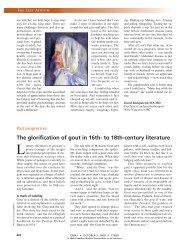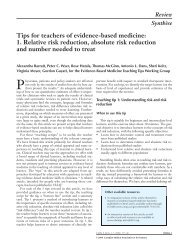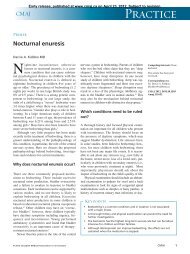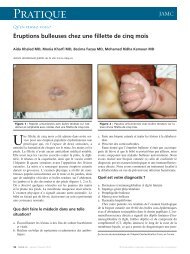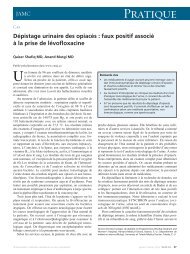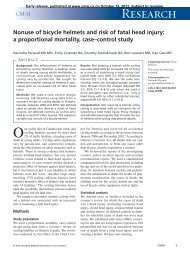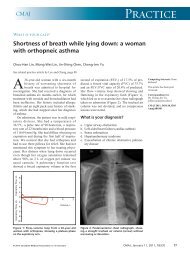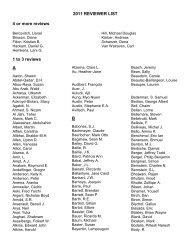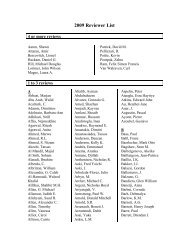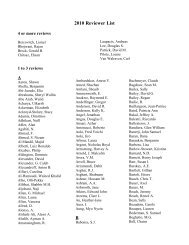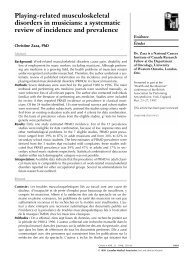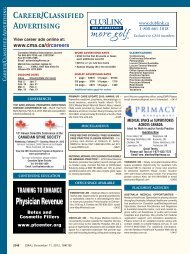Cochlear implants: the head-on collision between medical ...
Cochlear implants: the head-on collision between medical ...
Cochlear implants: the head-on collision between medical ...
Create successful ePaper yourself
Turn your PDF publications into a flip-book with our unique Google optimized e-Paper software.
Swans<strong>on</strong><br />
Bill Ir<strong>on</strong>side, L<strong>on</strong>d<strong>on</strong> Free Press<br />
Dianne Blair holds s<strong>on</strong> Lewis, who has a cochlear implant, as<br />
his bro<str<strong>on</strong>g>the</str<strong>on</strong>g>rs Liam (left) and Sam look <strong>on</strong><br />
cochlear implant she was an adolescent well adjusted to<br />
deafness. She declined.<br />
She went <strong>on</strong> to obtain a degree in psychology from<br />
<str<strong>on</strong>g>the</str<strong>on</strong>g> University of British Columbia and today teaches at<br />
an Ontario school for <str<strong>on</strong>g>the</str<strong>on</strong>g> deaf. Now 31, Springford has<br />
not regretted her decisi<strong>on</strong>, “not <strong>on</strong>ce, not for a single<br />
solitary sec<strong>on</strong>d. Parents are often so c<strong>on</strong>cerned that <str<strong>on</strong>g>the</str<strong>on</strong>g><br />
child is handicapped that <str<strong>on</strong>g>the</str<strong>on</strong>g>y may not see all <str<strong>on</strong>g>the</str<strong>on</strong>g><br />
choices and possibilities open to <str<strong>on</strong>g>the</str<strong>on</strong>g>m.”<br />
“Giving Lewis all <str<strong>on</strong>g>the</str<strong>on</strong>g> opportunity we could” was why<br />
<str<strong>on</strong>g>the</str<strong>on</strong>g> Blairs decided <str<strong>on</strong>g>the</str<strong>on</strong>g>ir s<strong>on</strong> would have an implant; 2 attempts<br />
to use hearing aids had failed. His parents had<br />
c<strong>on</strong>sidered lip reading and sign language, and <str<strong>on</strong>g>the</str<strong>on</strong>g>y had<br />
tried <str<strong>on</strong>g>the</str<strong>on</strong>g> auditory-verbal approach that employs residual<br />
hearing, but results were discouraging.<br />
“We felt if Lewis had some hearing and some language,<br />
it would give him more opti<strong>on</strong>s than if we pursued<br />
just sign language,” says his mo<str<strong>on</strong>g>the</str<strong>on</strong>g>r.<br />
“This decisi<strong>on</strong> was not taken lightly,” adds his fa<str<strong>on</strong>g>the</str<strong>on</strong>g>r.<br />
At age 2, Lewis received his cochlear implant at University<br />
Hospital in L<strong>on</strong>d<strong>on</strong>, Ont. Three years after <str<strong>on</strong>g>the</str<strong>on</strong>g><br />
surgery, his parents are c<strong>on</strong>vinced <str<strong>on</strong>g>the</str<strong>on</strong>g>y made <str<strong>on</strong>g>the</str<strong>on</strong>g> right decisi<strong>on</strong>.<br />
[In L<strong>on</strong>d<strong>on</strong> <str<strong>on</strong>g>the</str<strong>on</strong>g> procedure costs $36 748, including<br />
<str<strong>on</strong>g>the</str<strong>on</strong>g> cost of <str<strong>on</strong>g>the</str<strong>on</strong>g> implant and 2 days in hospital. — Ed.]<br />
Following surgery, he received intensive auditory-verbal<br />
training, attended a preschool for hearing-impaired<br />
children and had daily less<strong>on</strong>s at home. He recently<br />
scored well above his age group in a standardized language<br />
test.<br />
Kelley Blair says newer, 22-channel <str<strong>on</strong>g>implants</str<strong>on</strong>g> mean his<br />
s<strong>on</strong> “can detect and articulate far more of <str<strong>on</strong>g>the</str<strong>on</strong>g> frequency<br />
range. . . . He speaks in full sentences and his speech is<br />
clear and distinctive. He hears <str<strong>on</strong>g>the</str<strong>on</strong>g> full spectrum of sound<br />
. . . and his audiogram [results indicate that] he can hear<br />
low, high and middle frequencies all about basically <str<strong>on</strong>g>the</str<strong>on</strong>g><br />
same as a normal pers<strong>on</strong>, except he can’t hear <str<strong>on</strong>g>the</str<strong>on</strong>g>m as well.<br />
“It’s quite amazing what Lewis has d<strong>on</strong>e, and <str<strong>on</strong>g>the</str<strong>on</strong>g>re<br />
are o<str<strong>on</strong>g>the</str<strong>on</strong>g>r kids who have had <str<strong>on</strong>g>the</str<strong>on</strong>g> same results or better.<br />
The implant is a phenomenal device.”<br />
Dr. Lorne Parnes, <str<strong>on</strong>g>the</str<strong>on</strong>g> otolaryngologist who performed<br />
Lewis’ implant — he has completed <str<strong>on</strong>g>the</str<strong>on</strong>g> procedure<br />
about 65 times — says cochlear <str<strong>on</strong>g>implants</str<strong>on</strong>g> involve a<br />
“pers<strong>on</strong>al choice.” They are frequently chosen by hearing<br />
patients who become deaf as adults and “want to get<br />
back into hearing society.” Although <str<strong>on</strong>g>the</str<strong>on</strong>g>y may not restore<br />
full hearing, <str<strong>on</strong>g>the</str<strong>on</strong>g>y allow <str<strong>on</strong>g>the</str<strong>on</strong>g>m to do that.<br />
Parnes says 80% to 90% of deaf children live with<br />
hearing parents and siblings. “It’s <str<strong>on</strong>g>the</str<strong>on</strong>g> decisi<strong>on</strong> of parents<br />
to make whe<str<strong>on</strong>g>the</str<strong>on</strong>g>r <str<strong>on</strong>g>the</str<strong>on</strong>g>ir children should be part of <str<strong>on</strong>g>the</str<strong>on</strong>g><br />
hearing or deaf society,” he says. “We as parents are c<strong>on</strong>stantly<br />
making decisi<strong>on</strong>s about our children’s well-being,<br />
and this is <strong>on</strong>e <str<strong>on</strong>g>the</str<strong>on</strong>g>m.”<br />
He says parents wanting to make an informed choice<br />
will examine all <str<strong>on</strong>g>the</str<strong>on</strong>g> opti<strong>on</strong>s open to <str<strong>on</strong>g>the</str<strong>on</strong>g>ir child, including<br />
deaf culture. Parnes says most deaf parents of a deaf<br />
child are unlikely to even c<strong>on</strong>sider a cochlear implant,<br />
and adults who have been deaf since birth are unlikely to<br />
c<strong>on</strong>template it for <str<strong>on</strong>g>the</str<strong>on</strong>g>mselves.<br />
Parnes thinks <str<strong>on</strong>g>the</str<strong>on</strong>g> c<strong>on</strong>troversy surrounding cochlear<br />
<str<strong>on</strong>g>implants</str<strong>on</strong>g> may be lessening. “If you look at people who<br />
have had <str<strong>on</strong>g>the</str<strong>on</strong>g> <str<strong>on</strong>g>implants</str<strong>on</strong>g>, you can’t argue with success.”<br />
A deaf physician<br />
Dr. Hartley Bressler, a Thornhill, Ont., family physician<br />
who has been deaf since birth, sees both hearing and<br />
deaf patients in his practice and remains c<strong>on</strong>cerned about<br />
media reports that tell of “star cochlear implant recipients.<br />
The news <str<strong>on</strong>g>head</str<strong>on</strong>g>lines sensati<strong>on</strong>alize <strong>on</strong>e child’s ‘miracle of<br />
hearing,’ but <str<strong>on</strong>g>the</str<strong>on</strong>g> failures are never portrayed. I understand<br />
that most parents want <str<strong>on</strong>g>the</str<strong>on</strong>g> best for <str<strong>on</strong>g>the</str<strong>on</strong>g>ir deaf child,<br />
but good intenti<strong>on</strong>s do not guarantee success.”<br />
He argues that <strong>on</strong>e-<strong>on</strong>-<strong>on</strong>e testing by <str<strong>on</strong>g>the</str<strong>on</strong>g>rapists<br />
does not simulate “communicati<strong>on</strong>s most people experience<br />
in <str<strong>on</strong>g>the</str<strong>on</strong>g> hearing world. The research [c<strong>on</strong>cerning]<br />
cochlear <str<strong>on</strong>g>implants</str<strong>on</strong>g> is still in its relative infancy [and]<br />
<str<strong>on</strong>g>the</str<strong>on</strong>g>re are still too many unknowns and we are <strong>on</strong> a c<strong>on</strong>tinual<br />
learning curve as to its use, effectiveness and<br />
l<strong>on</strong>g-term ramificati<strong>on</strong>s.”<br />
930 CAN MED ASSOC J • 1 er OCT. 1997; 157 (7)



